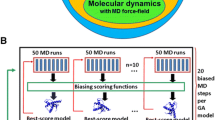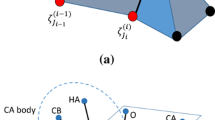Abstract
In this paper we propose PSICO (Processing Structural Information with Constraint programming and Optimisation) as a constraint-based approach to determining protein structures compatible with distance constraints obtained from Nuclear Magnetic Resonance (NMR) data. We compare the performance of our proposed algorithm with DYANA (“Dynamics algorithm for NMR applications”) an existing commercial application based on simulated annealing. On a test case with experimental data on the dimeric protein Desulforedoxin, the method proposed here supplied similar results in less than 10 minutes compared to approximately 10 hours of computation time for DYANA. Although the quality of results can still be improved, this shows that CP technology can greatly reduce computation time, a major advantage because structural NMR technique generally demands multiple runs of structural computation.
Similar content being viewed by others
References
Abe, H., Braun, W., Noguti, T., & Go, N. (1984). Rapid calculation of first and second derivatives of conformationalener gy with respect to dihedralangl es for proteins. generalr ecurrent equations. Computers Chemistry, 5(4): 239.
Archer, M., Huber, R., Tavares, P., Moura, I., Moura, J. J., Carrondo, M. A., Sieker, L. C., LeGall, J., & Romāo, M. J. (1995). Crystal structure of desulforedoxin from Desulfovibrio gigas determined at 1.8, A resolution: a novel non-heme iron protein structure. Journal of Molecular Biology, 251(5): 690.
Backofen, R. (1998). Constraint Techniques for Solving the Protein Structure Prediction Problem, CP98, Lecture Notes in Computer Science, Vol. 1520, page 72. Springer-Verlag.
Backofen, R. (2001). The protein structure prediction problem: a constraint optimisation approach using a new lower bound. Constraints, 6: 223.
Beldiceanu, N., & Contejean, E. (1994). Introducing Global Constraints in CHIP. Mathl. Comp. Modelling, 20(12): 97.
Buckle, A. M., Schreiber, G., & Fersht, A. R. (1994). Protein-protein recognition: crystal structural analysis of a Barnase-Barstar complex at 2.0-A resolution. Biochemistry, 33: 8878.
Bushnell, G. W., Louie, G. V., & Brayer, G. D. (1990). High-resolution three-dimensional structure of horse heart cytochrome c., Journal of Molecular Biology, 214: 585.
Cheng, B., Choi, K., Lee, J., & Wu, J. (1999). Increasing constraint propagation by redundant modeling: an experience report. Constraints, 4: 167.
Gaspin, C. (2001). RNA secondary structure determination and representation based on constraints satisfaction. Constraints, 6: 201.
Gilbert, D., Backofen, R., & Yap, R. (2001). Special issue on bioinformatics. Constraints, 6: 139.
Goodfellow, B., Rusnak, F., Moura, I., Domke, T., & Moura, J. J. G. (1998). NMR determination of the global structure of the 113Cd derivative of Desulforedoxin: Investigation of the hydrogen bonding pattern at the metal center. Protein Science, 7: 928.
Güntert, P., Mumenthaler, C., & Wüthrich, K. (1997). Torsion angle dynamics for NMR structure calculation with the new program DYANA. J. Mol. Biol. 273: 283.
Hecht, H. J., Szardenings, M., Collins, J., & Shomburg, D. (1991). Three-dimensional structure of the complexes between bovine chymotrypsinogen *A and two recombinant variants of human pancreatic secretory trypsin inhibitor (*Kazal-Type). J. Mol. Biol., 220: 711.
Jia, Z., Quail, J. W., Waygood, E. B., & Delbaere, L. T. J. (1993). The 2.0 angstroms resolution structure of Escherichia coli histidine-containing phosphocarrier protein HPR: a redetermination, J. Biol. Chem., 268: 22490.
Krippahl, L., & Barahona, P. (1999). Applying Constraint Programming to Protein Structure Determination, CP99, Lecture Notes in Computer Science, Vol. 1713, page 289. Springer-Verlag.
Krippahl, L., Trosset, M., & Barahona, P. (2001). Combining constraint programming and multidimensional scaling to solve distance geometry problems. In Proceedings of CP-AI-OR'2001, Imperial College, Kent UK, 67–80.
Leishman, S., Gray, P. M. D., & Fothergill, I. E. (1994). ASSASSIN: a constraint based assignment system for protein 2D nuclear magnetic resonance. In Milne, R., & Montgomery A., eds. Applications and Innovations in Expert Systems II, (Proceedings of Expert Systems 94, Cambridge), page 263.
Marquart, W., Deisenhofer, Bode J., & Huber, R. (1983). The geometry of the reactive site and of the peptide groups in trypsin, trypsinogen and its complexes with inhibitors, Acta Crystallography, Section B, 39: 480.
McCoy, M., Stavridi, E. S., Waterman, J. L., Wieczorek, A. M., Opella, S. J., & Halazonetis, T. D. (1997). Hydrophobic side-chain size is a determinant of the three-dimensional structure of the P53 oligomerization domain. EMBO JOURNAL, 16: 6230.
Revesz, P. (1997). Refining restriction enzyme genome maps. Constraints, 2: 361.
Rodošek, R. (2001). A constraint-based approach for deriving 3-D structures of cyclic polypeptides. Constraints, 6(2&3): 257.
Sam-Haroud, D., & Faltings, B. (1996). Consistency techniques for continuous constraints. Constraints,1.
Zimmerman, D. E., Kulikowski, C. A., & Montelione, G. T. (1993). A constraint reasoning system for automating sequence-specific resonance assignments from multidimensional protein NMR spectra. Ismb 1: 447.
Author information
Authors and Affiliations
Rights and permissions
About this article
Cite this article
Krippahl, L., Barahona, P. PSICO: Solving Protein Structures with Constraint Programming and Optimization. Constraints 7, 317–331 (2002). https://doi.org/10.1023/A:1020577603762
Issue Date:
DOI: https://doi.org/10.1023/A:1020577603762




